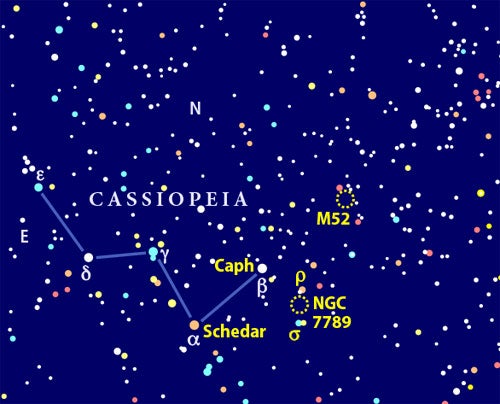This time of year, Cassiopeia rides high above Polaris and looks resplendent in the Milky Way’s gentle glow. Let’s set our binoculars on this dazzling target.
One of my favorite open clusters in Cassiopeia is M52. To find it, draw a line from Schedar to Caph, the westernmost stars in the W pattern, and continue it an equal distance to the northwest. There, you should spot a slender, four-star diamond pattern. M52 lies to the diamond’s south.
Although about 200 stars call M52 home, few are bright enough to crack the binocular barrier; the rest blend into a little cloud of misty starlight. Whenever I look at M52 through binoculars, I recall what Charles Messier saw when he discovered the group September 7, 1774. He described it as “a cluster of very small stars mingled with nebulosity.”
Sit back and scan the area around M52 for interesting knots and small clumps of stars. Try to look for patterns and create your own mini-constellations. That’s exactly what John Davis was doing when he bumped into a little pattern that’s just to the northwest of M52.
One such pattern is in the same binocular field as M52. See anything? Before reading on, go outside and find M52 through your binoculars. Then, with M52 centered in the view, shift your attention just to its northwest. You’ll see a lot of stars, but do any seem to form a recognizable pattern?
To Davis, they do. He sees an airplane. The four stars in our narrow diamond frame its wings. As Davis explains, “The plane’s brightest star [labeled as 4 Cassiopeiae on star atlases] marks the end of the eastern wing, while a lone 6th-magnitude star lies at the tip of the western wing. A short arc of faint stars stretching northward forms the plane’s crooked tail.” Now, when I look at it, I say, “Of course, there it is.” Good eyes, John!
As long as we’re hunting for asterisms, look a little to the northwest of the “Davis airplane,” into Cepheus. Can you find a half circle formed by a dozen 8th-magnitude stars? The arc measures about 1.5° across, and, to me, it looks like a sideways bowl or maybe a satellite television dish antenna.
Once you’ve enjoyed M52, the Davis airplane, and the Dish, return to the star Caph in the Cassiopeia W and have a look around. Can you spot three pairs of stars just to its south-southwest? Although none of these is a true binary star system, each pair forms the corner of a slim triangular asterism that reminds me of a skinny hang glider. The brightest star in the asterism, Rho (ρ) Cassiopeiae, is one of the two at the nose of the hang glider, while 5th-magnitude Sigma (σ) Cassiopeiae — the brighter of the two stars — is at the end of the southern wing.
You might even spot a faint stain on the leading edge of the glider’s southern wing. That’s actually NGC 7789, a distant open cluster discovered in the fall of 1783 by Caroline Herschel, William’s sister. Don’t expect to see a lot of stars through your binoculars, however. Instead, NGC 7789 looks like a faint, round glow with perhaps one or two elusive points shining through.
There are many more star clusters visible through binoculars within Cassiopeia.
Next month, we’ll shift our attention from mother to daughter as we go hunting for deep-sky targets in Andromeda. Till then, remember: Two eyes are better than one.











